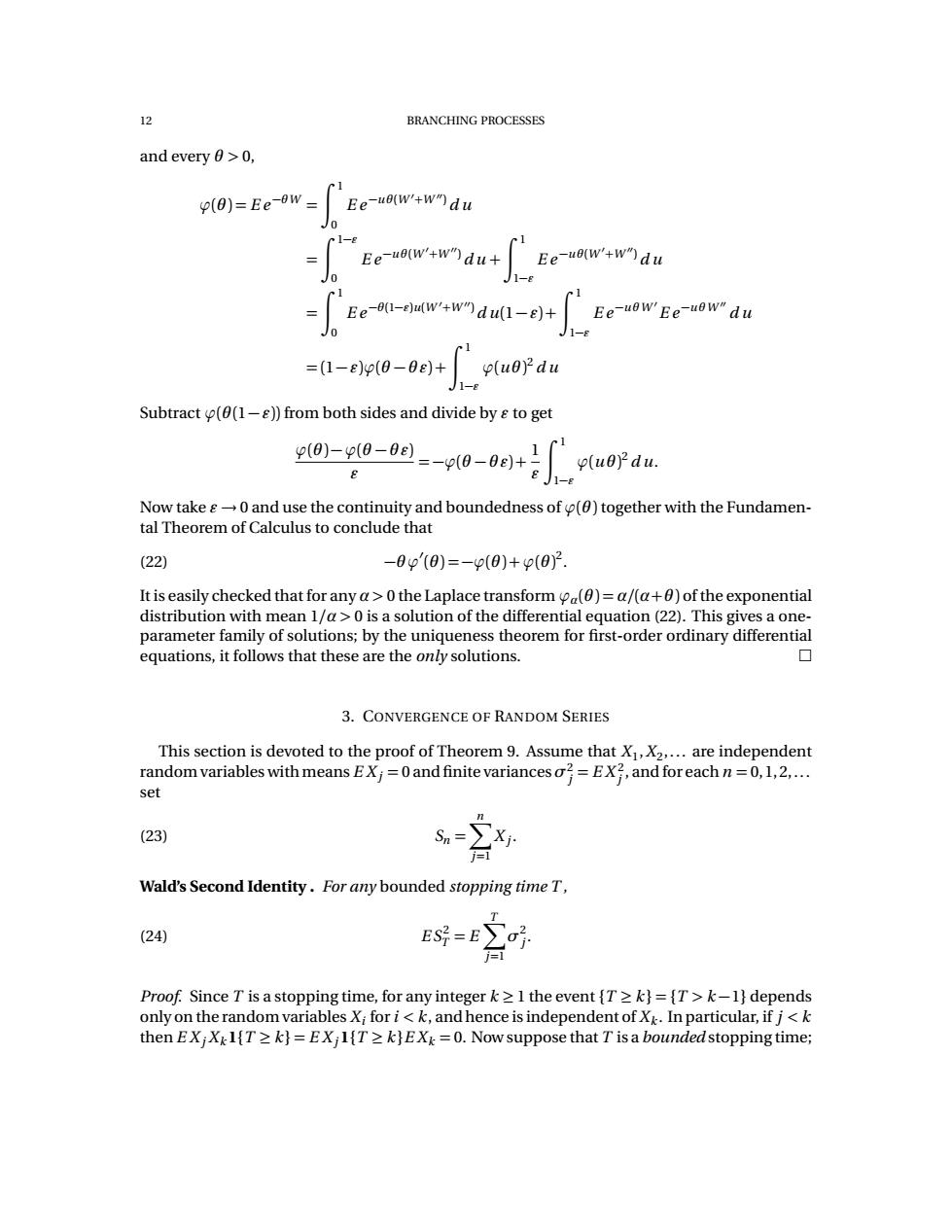正在加载图片...

BRANCHING PROCESSES and every 0 >0, 个1 p(0)=Ee-9w= Ee-uo(w'+wdu 10 Ee-uw'+wdu+ Ee-uo(w'+w")du Ee-0-uww)du(1-)+Ee-wow'Ee-wow"du =n-840-a+ (u0)2du Subtract (0(1-g))from both sides and divide by to get 20-y0-0a.-y0-89+ o(u0)2du. Now take g-0 and use the continuity and boundedness of ()together with the Fundamen- tal Theorem of Calculus to conclude that (22) -0p'(0)=-p(0)+p(02. It is easily checked that for any a>0 the Laplace transform ()=a/(a+0)of the exponential distribution with mean 1/a>0 is a solution of the differential equation(22).This gives a one- parameter family of solutions;by the uniqueness theorem for first-order ordinary differential equations,it follows that these are the only solutions. 口 3.CONVERGENCE OF RANDOM SERIES This section is devoted to the proof of Theorem 9.Assume that X1,X2,...are independent random variables with means EXj=0and finite varianceso=EX?,and foreach n=0,1,2.... set 7 (23) Wald's Second Identity.For any bounded stopping time T, T (24) ES=E∑o j=1 Proof.Since T is a stopping time,for any integer k>1 the event [T>k}=[T>k-1}depends only on the random variables Xi for i<k,and hence is independent of Xk.In particular,if j<k then EXiXk1{T >k}=EXi1{T>k}EXk =0.Now suppose that T is a boundedstopping time;12 BRANCHING PROCESSES and every θ > 0, ϕ(θ ) = E e −θW = Z 1 0 E e −uθ (W 0+W 00) d u = Z 1−" 0 E e −uθ (W 0+W 00) d u + Z 1 1−" E e −uθ (W 0+W 00) d u = Z 1 0 E e −θ (1−")u(W 0+W 00) d u(1 − ") + Z 1 1−" E e −uθW 0 E e −uθW 00 d u = (1 − ")ϕ(θ − θ ") + Z 1 1−" ϕ(uθ ) 2 d u Subtract ϕ(θ (1 − ")) from both sides and divide by " to get ϕ(θ ) − ϕ(θ − θ ") " = −ϕ(θ − θ ") + 1 " Z 1 1−" ϕ(uθ ) 2 d u. Now take " → 0 and use the continuity and boundedness of ϕ(θ ) together with the Fundamental Theorem of Calculus to conclude that (22) −θ ϕ0 (θ ) = −ϕ(θ ) + ϕ(θ ) 2 . It is easily checked that for any α > 0 the Laplace transform ϕα(θ ) = α/(α+θ ) of the exponential distribution with mean 1/α > 0 is a solution of the differential equation (22). This gives a oneparameter family of solutions; by the uniqueness theorem for first-order ordinary differential equations, it follows that these are the only solutions. 3. CONVERGENCE OF RANDOM SERIES This section is devoted to the proof of Theorem 9. Assume that X1 ,X2 ,... are independent random variables with means E X j = 0 and finite variances σ 2 j = E X 2 j , and for each n = 0, 1, 2,... set (23) Sn = Xn j =1 X j . Wald’s Second Identity . For any bounded stopping time T , (24) E S2 T = E X T j =1 σ 2 j . Proof. Since T is a stopping time, for any integer k ≥ 1 the event {T ≥ k} = {T > k −1} depends only on the random variables Xi fori < k, and hence is independent of Xk . In particular, if j < k then E X j Xk1{T ≥ k} = E X j 1{T ≥ k}E Xk = 0. Now suppose that T is a bounded stopping time;�